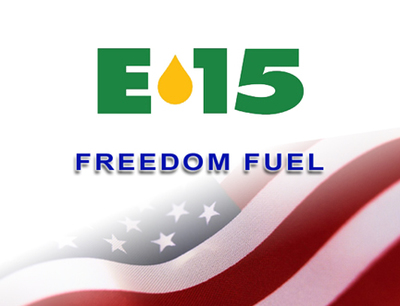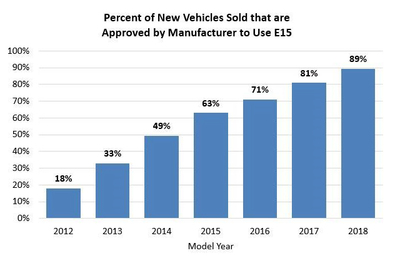Automakers Approve E15 in Nearly 90% of New 2018 Vehicles
 |
WASHINGTON - November 16, 2017: According to an analysis conducted by Renewable Fuels Association, nearly 90 percent of new 2018 model year (MY) vehicles are explicitly approved by the manufacturer to use 15 percent ethanol blends (E15), according to the results of an annual analysis of warranty statements and owner’s manuals conducted by the Renewable Fuels Association (RFA). That is up from last year, when approximately 81 percent of MY2017 vehicles were formally approved by automakers to use E15.
For the first time, Nissan Motor Company has warrantied the use of E15 in most of its MY 2018 vehicles, joining the majority of its competitors. Together, Infiniti and Nissan represent slightly more than 9 percent of the U.S. light-duty automobile market. Language allowing the use of E15 appears in the owner’s manuals for popular Nissan models, including the Altima, Maxima, Pathfinder, Rogue, and Sentra, as well as Infiniti’s QX60, Q60, Q70, and certain Q50 models.
Other key points from RFA’s analysis include:
• The Detroit Three (Chrysler, General Motors and Ford), which collectively represent 44% of U.S. market share, all continue to clearly allow E15 in their vehicles. GM started approving the use of E15 with its MY 2012 vehicles, while Ford joined the following year and Chrysler began E15 approval with its MY 2016 vehicles.
• Other large automakers explicitly offering E15 approval for MY 2018 vehicles include Toyota, Honda, and Hyundai/Kia. Altogether, auto manufacturers with 89.4 percent of 2017 U.S. market share now approve the use of E15 in their MY 2018 vehicles.
• Subaru, Daimler (maker of Mercedes-Benz), and Mazda remain the largest vehicle manufacturers that still exclude E15 from owner’s manual fuel recommendations and warranty statements, together representing about 7.5 percent of U.S. market share. It should be noted, however, that Mercedes-Benz offers three of its most popular models as flex fuel vehicles (FFVs) capable of operating on up to 85 percent ethanol.
• With 1.7 percent of the U.S. market, BMW also continues to exclude E15 from its fuel recommendations. However, BMW Group’s Mini vehicles again allow the use of up to 25 percent ethanol blends.
In 2012, EPA approved the use of E15 in vehicles built in MY 2001 or later. However, auto manufacturers did not retroactively endorse the use of E15 in legacy vehicles that were already on the road. Since 2012, however, the number of major automakers approving the use of E15 has grown from one (General Motors) to 10.
RFA estimates that approximately 34 percent of the estimated 235 million cars, trucks, and SUVs on the road today are clearly approved by the automaker to use E15 (including FFVs). Meanwhile, more than 90 percent of vehicles on the road were built in 2001 or later, meaning they are legally approved by EPA to use E15.
“Automaker acceptance and approval of E15 continues to expand rapidly, and almost all new 2018 vehicles carry the manufacturers’ explicit allowance to use this lower-cost, cleaner-burning, higher octane fuel,” said RFA President and CEO Bob Dinneen. “This analysis should put to rest any myths still being propagated by the American Petroleum Institute and its cronies that automakers don’t allow or warranty the use of E15. We applaud Nissan for joining the ‘E15 Club’ with its model year 2018 vehicles, and we will continue to work with the few remaining automakers who haven’t yet included E15 in their fuel approvals. We’re thrilled to see Mini continuing to blaze the trail toward greater consumer choice. By allowing the use of optimal high-octane fuel blends like E25 in conventional autos, Mini continues to set the pace.
“The oil company explanation for their failure to invest in infrastructure allowing E15 has been there isn’t sufficient demand for E15 because it isn’t warrantied. Well, that narrative has been misleading for years, but now it is completely bankrupt. As this analysis shows, 34% of the cars on the road today have full warranty coverage for E15. That compares to only about 10% of vehicles that require a premium fuel. Oil companies have invested in the infrastructure for premium, but why not for E15? The answer is obvious, they want to preserve their monopoly at the pump. But consumers deserve better. Consumers deserve higher octane fuels at lower prices. That’s what E15 provides. It’s time for the oil industry to stop erecting barriers to higher ethanol blends, and start serving the consumer,” Dinneen added.
Recently E15 has been experiencing incredible growth in the marketplace and it is sold today at more than 1000 retail stations in 29 states.



